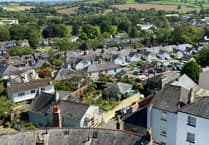With the recent rains that followed weeks of dry weather, pollution warnings have been issued by the Environment Agency for beaches along the South Devon coast at Paignton, Goodrington, Dawlish, Exmouth, Budleigh Salterton, Teignmouth, Sidmouth, Beer and Wembury. The advice to bathers was not to go into the sea. South West Water’s bathing water information service, BeachLive, advises that alerts are issued “when stormwater overflows may temporarily affect bathing water”, which can be understood to mean when rainwater mixed with raw sewage is being discharged into our rivers and sea.
In the South Hams, only Wembury, with its precious underwater nature reserve, was subject to warnings this time. But in East Devon local businesses have reported on the impact as holidaymakers chose to stay away from the polluted beaches. We may not be so lucky next time. The aptly named website Top of the Poops reports that in 2021, there were 4,001 sewage dumps of 27,465 hours duration in Totnes constituency!
Dr Nicola Rogers, Senior Project Manager at the Westcountry Rivers Trust, reported that, “Across the South West region, only one in five rivers meet Government standards. Currently, only 50 per cent of rivers and streams in the Dart and the Avon catchments show good ecological status, and only one of the seven water bodies in the Erme catchment meet the standard. Our rivers are affected by pollution from urban industry around Plymouth, sewage discharges from South West Water, diffuse run-off and point source pollution from the surrounding agricultural land. This can lead to elevated levels of chemical (e.g. phosphates and pesticides) and microbiological (e.g. faecal coliforms) contamination (from livestock waste).”
The Environment Act that was passed last November is intended to “secure a progressive reduction in the adverse harm” caused by sewage dumps, but the Government rejected an amendment that would have placed a legal duty on water companies and the Government to demonstrate progressive reductions in discharges of untreated sewage and to “take all reasonable steps” to avoid using combined sewer overflows. The Government has said it intends to produce a plan by September this year to reduce storm overflows. This was made a legal requirement by the Environment Act 2021. Let’s hope that this happens. The recent pollution events demonstrate that Government needs to establish proper timetables and targets for companies to reduce sewage discharge as rapidly as possible.
The failure to protect the water quality of our rivers and seas has an impact on our health and wellbeing, affects our local tourism businesses and is devastating to the wildlife that live in our local waters. But it is also contributing to increasing carbon emissions. Each year, oceans absorb 20-35% of our CO2 emissions, but can only do this if the plants and animals that live in them are healthy.
Our coastal waters should be home to extensive beds of seagrass, an underwater flowering plant that grows in the shallow waters around our coast. Seagrass meadows combat climate change by absorbing and storing huge amounts of carbon. According to the Ocean Conservation Trust, “They are up to 35 times more efficient at absorbing carbon than rainforests of the same area”.
Plymouth Sound is one of two locations for England’s largest seagrass planting programme with 4 hectares of seagrass meadow being restored. The Ocean Conservation Trust is replanting the seagrass that has been lost to stabilise the seabed, clean the surrounding seawater and capture and store carbon. It will also provide homes for juvenile fish and protected threatened creatures like seahorses. But to thrive it needs to be protected from pollution.
We need concerted Government action to tackle these issues. But farmers and landowners too can improve water quality by creating buffers alongside rivers to protect them from harmful agricultural pollution. Planting trees on and around riverbanks, or allowing them to grow naturally, improves water quality by blocking the run-off of pollutants into rivers. It also reduces flood risks by slowing the flow of water, boosting wildlife by creating new wild corridors and makes our rivers more climate resilient by providing shade and cooling water temperatures.
We can all play our part by choosing water permeable surfaces and natural planting for our gardens and driveways that allow rainwater to permeate and drain away. Please don’t be tempted to replace your parched brown lawn with an artificial lawn – they are a disaster for the creatures that live in the soil and our insects and birds. Choosing living trees and plants and permeable surfaces reduces the rainwater that would otherwise run off paved and hard surfaces pouring into drains, creating the surge in stormwater that leads to storm overflows dumping raw sewage into our water.
You may like to become a volunteer citizen scientist for the Westcountry Rivers Trust through its Citizen Science Investigation programme and learn how to take water samples from your local river providing valuable data, and become a custodian of your local river (see wrt.org.uk).
And if you are heading to the beach, download the Safer Seas and Rivers Service app from Surfers Against Sewage, an interactive map monitoring 400 locations around the UK coast, issuing alerts based on real-time tracking of combined sewage overflows and pollution risk forecasts. Good to know before you take a dip.



